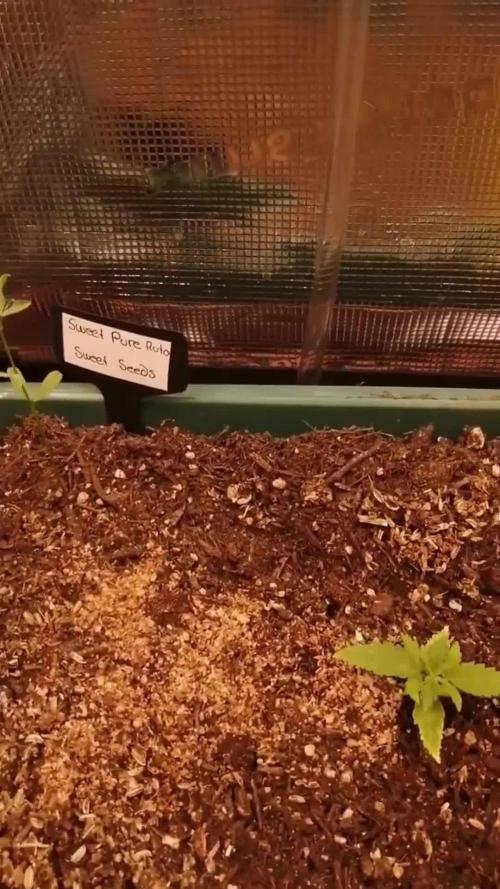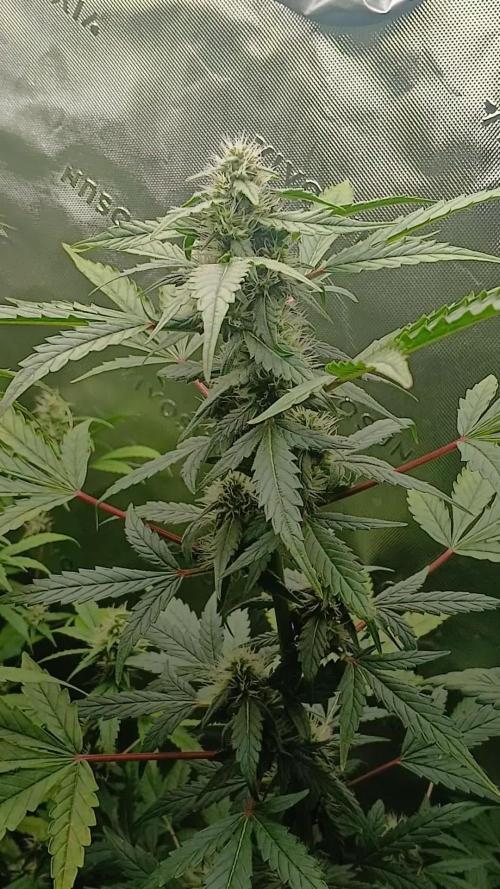The Grow Awards 2026 🏆 





























Likes
8
Share


@IndoorHealer
Follow
Its was great to finally grow my own weed , i felt really good and im so happy with the result , my best choice was to get a experienced guy to help me trought the way , it definitely saved me a lot of time and mistakes , thanks to @bengrowerbr instagram . Now i have two headbangers already flowering on my grow , those are not from any seedbank but they are looking great , i will give her a diarie as well , thanks for being here and lets get medicated!
Likes
6
Share


@Sensiseeker
Follow
Filling in nicely has a great smell starting to frost up.
My haze beast smells very sweet like fruit loops cereal.
Light took a crap almost 10 days ago only 9 months old. Its a medic grow smart 8. After dealing with getting it replaced in the middle of a grow I am done with them. They make a great light, but the service is terrible. You are forced to work with someone in China who will respond to you at 2am. I had to call, text, email, FB msg and msg through IG to get a response and someone to replace my light. It should be here Tuesday. I bought a Mammoth mint today and am going to run that from now on.
11/20 Grape God has a smell of grape and rubber is the best way I can describe it. The haze beast smells Identical to fruit loops almost caught up to the GG in height.
Likes
11
Share


@Genussmittel420
Follow
day 1 - she is still growing
day 4 - removed her LST string now. really like her shape and might even go for topping later in the grow
day 6 - applyed a new string for more funny curves. without the LST she would be about 42cm
Likes
31
Share


@MMSC16
Follow
Nov 13 - Day 94 - More bulking up, girls are holding water longer. Watered Older plant at 7.45PM. Started defoliating withered leaves with trichomes, I'm keeping those for now, and will combine with bubble hash trim.
Nov 14 - Day 95 - Both pots aren't super light so I'll wait until tomorrow and water both at the same time. Starting to think about drying and harvest, I suspect there to be a fortnight between each harvest - but unsure if I can afford the tent space with next run growing. I think I'll water either as lights turn off (if humidity wont rise) or first thing on Nov 15.
Nov 14 - Trichomes are milky with the speckle of clear and amber. Lets hope the lagging cola fattens up in the week to come.
Nov 14 - WATERED Younger plant at 10.30PM.
Nov 15 - Watered Older plant at 3PM
Nov 16 - Watered Younger plant at 5PM
Nov 17 - Woke up to 80F. Likely at higher temp for 1 hour before noticing. Defoliated a few leaves, including one or two with trichomes, of which I've saved.
Nov 18 - Watered Older plant at 6AM. Younger plant pot is light at lights off- will water first thing in the morning. Also removed dead tips and accidentally chopped a healthy fan leaf. I was hoping to chop today, but it might be another week before the younger plant is ready.
Nov 19 - DAY 100 - Watered Younger plant at 10.30AM. Trichomes are developing nicely, I suspect 1 more week with younger plant which makes me wonder when to chop older plant.
Likes
18
Share


@eldruida_lamota
Follow
Que pasa familia, vamos con la novena y última semana de floración de estas Tropicana Cookies Fast Flowering, de FastBuds.
Los ejemplares tienen muy buen color han crecido muy uniformes y las flores han acabado de madurar.
El ph se controla en 6.2 , la temperatura la tenemos entre 21/24 grados y la humedad ronda el 50%.
Se quitó la alimentación hace 2 semanas solo estuvieron agua y poco más , ya cuando coseche diré resultados finales.
Mars hydro:
Code discount: EL420
https://www.mars-hydro.com/
Agrobeta:
https://www.agrobeta.com/agrobetatiendaonline/36-abonos-canamo
Hasta aquí todo, Buenos humos 💨💨💨
Likes
22
Share


@Gram_Solo
Follow
🔥🔥🔥 week 12 smashing it!
I am flushing the main lined plant, the thai stick looking one and the big purple this week !
2 plants just on Overdrive and bloom for 1 more week or 2 then onto the flushing
The colours on the leaves of the main line plant almost have a blue and gold tone to them, mad! buds are frosty!
Buzzing with these autos! 🙌👊🔥
Crazy colours
Will update soon
👽👍
Likes
101
Share


@Ferenc
Follow
Day 65, 17th of November 2020:
Welcome back at the beggining of the 3rd week of flowering. They seem to be stopped streching and now concentrating on buds.
All of them are gorgeous.....
The 2 Zamnesia genetics Gelato and Kalini Asia are pretty and buds are forming nicely. Kalini Asia might strech a bit more but not long.
The Sweet Seed ones are really nice and I am so happy because Red Hot Cookies is already getting red.... pistils and around the leaves.. I hope the same happens to the Red Mandarine and Tropicanna Poison also. They are so gorgeous. They calmed down I don't expect more strech.
Fertilization still the same every 2nd day with the ratio and mix above.
Some lollipopping (Defoliation) is also done.
I removed all the LST the plant remains in the same shape from now.
The lamp is on 11.30 min and off 12.30 min.
Last week was 15 min longer light cycle....
So every week 15 min shorter light cycle until the 5th week. So far -30 min. It switches on at 6 am and off at 17.30 pm.
Likes
11
Share


@All_our_small_plants
Follow
Bewässerung: 500 ml jeden 3 tag in der zweiten Woche
pH-Wert: 5,8
EC-Wert: 0,6
Temperatur: 30ºC
Luftfeuchtigkeit 68%
Schädlingsbekämpfung:
PPFD: 200 µmol/m²/s
DLI
Düngemittel: organischer Dünger 4,2-0,8-4 💩
Besonderheiten: wir versuchen bei diesem Grow Effektive Mikroorganismen aus. Die Opfer Linsen sind wieder da 😜
-Tag 8 Heute hat sie Nematoden bekommen 😝
-Tag 10 Heute wurde sie mit organischem Dünger gegossen 4,2-0,8-4 💩
-Tag 12 wir haben ihr wieder etwas Dünger gegeben und wir haben entschieden dass wir sie nur mit organischem Dünger gießen werden um den Unterschied zum mineralischen Dünger zu beobachten 👋
-Tag 14 Sie hat heute nur Wasser bekommen. Sie wachst etwas langsamer als die anderen die gleichzeitig gekeimt sind
Likes
9
Share


@masterofsmeagol
Follow
6/15 Everything was dry this morning but the bags STILL had some heft. Much lighter though so I decided to water. I didn't realize how cold the hose is so I'll have to usecthe water inside or premix it. I watered everything at least a half gallon. Things are going great. I'll update as I go.
UPDATE: IM GLAD I WATERED. ITS 73° OUT AND NICE AND SUNNY.
6/16 Foggy morning has turned into a sunny day! Plants are doing amazing. So glad I watered. I took a shit ton of pictures but they don't seem to be uploading. VERY FRUSTRATING TO TAKE THE TIME TO TAKE PICS AND VIDEO ONLY TO HAVE IT NOT UPLOAD. It's working now. I canceled out after I uploaded everything. Trying to upload again now.
EDIT: EVERYTHING IS FIXED. I UPLOADED A BUNCH OF STUFF. PLANTS IN THE BACK AND THE FRONT SEEMED DRY AND LIGHT. I GAVE THE TWO 10'S AT LEAST A HALF GALLON. I GAVE THE THIRTY A GALLON AND SPLIT THE REMAINDER WITH THE 20'S. I MIXED UP 5 GALLONS. EVEN THOUGH THE PLANTS IN THE MIDDLE WERE DRY THEY STILL WERE FAIRLY HEAVY. IT IS SUNNY AND 80° WITH STRONG WIND. I'LL WATER THE OTHERS IF NEEDED BEFORE WE GET SOME RAIN. WE HAVE RAIN IN THE FORECAST SO ILL KEEP AN EYE OUT. IM VERY IMPRESSED WITH THE GROWTH IM SEEING. I NEED TO DO SOME MORE LST SOON AND PUT UP A TRELLIS.
6/17 I'm glad I watered those plants. Everything is looking GREAT! I didn't get pictures as I was in a hurry. The 3 plants in tje middle are dry on top bit about as heavy as the others. The wind doesn't go through them like the others. I would've watered but they looked happy and we are supposed to be getting rain. I'll be back over later and re-evaluate.
EDIT: I GAVE THE THREE IN THE MIDDLE ABOUT A HALF GALLON EACH. EVERUTHING IS LOOKING FANTASTIC. I LSTED SOME. ITS SUPPOSED TO RAIN TONIGHT AND A LITTLE BIT WITHIN THE DEW DAYS BUT NOT WHAT THEY NEED. IM JUST TRYING TO NOT OVER WATER. IM REALLY HAPPY WITH WHAT IM SEEING.
6/18 It's overcast with showers. Rained hard last night and it's been raining off and on this morning. I probably could've made it without watering the three in the middle but I didn't want to chance it. Plus the rain doesn't add up to much anyway. Plants were soaked this morning. Soaked me just shaking them off. I'll update later. This year has been really good so far.
6/19 Overcast and Maineing out (tiny sprinkles tuat appear intermittently). Plants love it. Apparently I've reached my photo limit. At least that's what the app says. AT least I got SOME of these pictures and the video up. I can't belueve the increase in size both vertically, laterally and width. Branches are long and thick. This rain, sun, rain, sun type weather is creating some monsters. Can't wait to see the result. Still on the fence about light depoing. One thing I DO need to do is put up trellises. It sucks if I can't upload anymore pictures or videos. If I see something great I'll just delete a dfferent picture.
6/20 Not raining but still overcast. 71° at 9:15. Plants are still doing amazing. I've dedoliated some damaged old leaves. I can see some plants have shot a few pistols but I don't think reveg will be a big problem. Some have no signs of reveg. A couple spit out a few three finger leaves but that could be from the environmental stressor. I kept my second mk ultra without topping or fimmed. It's stalk is enormous and just the LEAFLETS are bigger than my wrist. ENORMOUS fan leaves. I think this is going to be a great year.
Likes
26
Share


@BudBoutique
Follow
! this is my current status, gonna upload my last veg weeks within the next week - got a bit busy around Spannabis - thank you for your understanding! 💚
Welcome to Bud Boutique Grow Diary - really appreciate all your love and support :)
Dont forget to check out my other current grows!
🗓️ This Week:
- Day 24: attaching once a week APTUS Foliar with Regulator & Nutrispray with the amazing CannaFogger by Petra Grow
- Day 28: bud development is super beautiful and praying up
Thank you for still staying with me 💚
___________________________________________
--- 🌱 Strain (Sponsor) ---
🏷️ Blue Cinderella 99 FF by MSNL
https://www.marijuana-seeds.nl/blue-cinderella-99-fast-flowering
--- 🥗 Nutrients and Feeding (sponsored by APTUS: APTUS Ambassador) ---
🍸 APTUS: full nutrient schedule extreme
-- Regulator, N-Boost, P-Boost, CaMg-Boost, K-Boost, Allin1 Liquid, Startbooster, Topbooster, Enzym+ every feeding
-- Fulvic-Blast, NutriSpray as Foliar each once a week
🔗 https://aptus-holland.com/
--- ♻️ Grow Control (Sponsor) ---
TROLMASTER: TENT-X + LM14 Light Adapter to dim/sunrise/sunset lights + Temp & rH Sensor all remote on App
🔗 https://www.trolmaster.eu/
--- 🚿 PetraGrow (Sponsor) ---
CannaFogger Foliar Spray
🔗 https://www.petratools.com/product/petragrow-cannafogger-atomizer-new-mini-fogger
--- 🏭 Grow Setup ---
💡LUMATEK Zeus Pro 600
* 🏠🌿 Indoor: Homebox 120x120x200cm (4x4)
* 📐🌀 PrimaKlima exhausting Fan 1180m3/h (running on 60-80%)
* 🌀 Can Light Filter 800m3/h & 1x Fanbox 1x Dyson fan for Air circulation
🔗 https://lumatek-lighting.com/zeus-600w-pro-29/
🔗 https://primaklima.com/de/shop/ventilatoren-de/ec-ventilatoren/pk160ec-tc/
🔗 https://canfilters.com/products/filters/
All Likes and comments are highly appreciated!!!
👨🌾 don't forget to check out my Instagram for daily educational content: budboutiquee
- Bud Boutique
Likes
Comments
Share


@c1note
Follow
30.11 runter mit Pk13/14 auf 0.75ml von 1ml. Hoch mit Boost von 1ml auf 2ml /L. Sie ist mir ein bisschen zu grün geworden. Darum runter auf Ec. 2.2.
2.4 (Vortag)
28.11 Canna pk kommt morgen rein + HesiBoost statt CannaBoost (leider leer). Dli 38-42. VPD 1.20.
27.11 Start Woche 4 Blüte. 2L mit 2.25 Ec. Dli 38-42. VPD 1.22.
Likes
8
Share


@ATLien415
Follow
I was amazed with the purple dripping down the scissors. The harvest is in the dry tent with an estimated dry of 10 days, weather depending. From experience I imagine there is a 1/4 lb dry and I know I have some hash to look forward to. The Cadillac RainbowZ always delivers on that front. 👽
as of 3/15 the dry is going chef's kiss, perfect humidity control with my rigged up CloudForge T3, dry trimmed today; they'll be going into jars on 3/17
as of 3/17 the dry is complete
HARVEST SUMMARY
-185 grams grade A buds (10 grams knocked off during dry trim additional) for 7 ounces total
- 1.6 grams bubble hash from scissors/gloves, and yeah she bubbles nice
- 1 gallon ZipLoc full of sugar leaf dried, frozen then beat then sifted for 9 grams of 93 micron dry sift grade A hash with an additional 2.5 grams of grade B hash after refusing to clean my screen again
Likes
1
Share


@BlunthumbMD
Follow
Absolutely stunning in all aspects at this stage, smells of diesel and citrus.
Likes
18
Share


@ReefermanGenetics
Follow
This is week 4 we are about to flip them to flower. 8 strains being test grown new strains.
Likes
68
Share


@Prototype0181
Follow
The bud-ignitor is doing what it's supposed to do, Buds are already forming on the cherry's @ day 8. Switching to Canna terra flores next week and stop using the bud-ignitor, also i gonna introduce Budfactor X @ the end of the week. Also when the stretch phase is over i gonna do a defol and lollipop again cause it's getting crowded lol
Rock on Dr Greenthumb's🌱


























